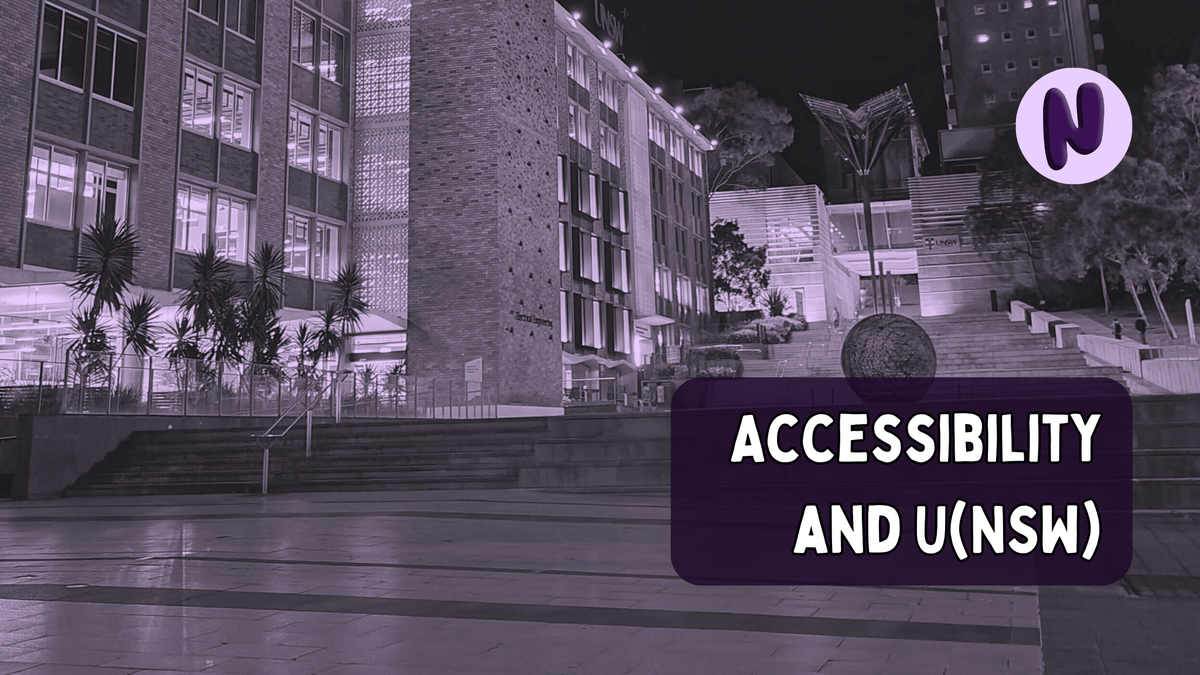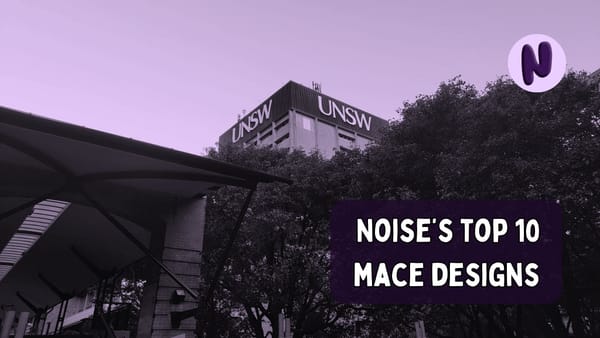Accessibility and U(NSW)
We delve into the issues with accessibility at UNSW.

UNSW’s Kensington campus is not easy to navigate. With its large number of walkways and stairs, inconsistent building names and hard-to-find classrooms, almost all students have experienced difficulty in getting to class at some point. For disabled students, navigating the campus is not only difficult but exhausting, classrooms can often be inaccessible and support resources can be unhelpful and hard to work with.
“[F]iguring out how to get anywhere…can be so confusing and difficult” states a respondent to an anonymous survey that Noise conducted to understand the experiences of disabled students navigating the Kensington campus.
The campus has a number of “accessible routes” that avoid use of the campus’ hundreds of stairs, however, these routes are often extremely difficult to find. Signposts highlighting these routes are small, difficult to see, and unclear as to where they are directing you. The online resources to find accessible routes aren’t any better. UNSW’s official campus accessibility map not only features a crowded and confusing UI that is inaccessible to many people, but is also laggy, prone to crashing, unaware of certain routes, and provides confusing directions. Third-party applications, such as Lost On Campus, do not provide a solution either, as they often do not have information about accessible routes.
Even when one manages to find an accessible route, their journey may not get any easier. As many of these routes are out of the way, they often lack adequate lighting and are poorly maintained with leaves, debris, and equipment blocking them. These routes can also be very long and convoluted, meaning that they take a large amount of additional time to traverse compared to the standard routes. This time increase is exacerbated by the fact that many routes on upper campus cross over busy walkways, meaning one must stop and wait for foot traffic to die down before they can cross over.
Not only do these routes take a long time to use but the ground they are on is often very uneven, this can not only make areas painful to traverse but also extremely dangerous due to the risk of falling over or tipping one’s mobility aid, especially in wet weather.
Some ramps on these “accessible routes” feature very tight turns with one respondent noting that it “makes them pretty difficult to use without crashing into the walls” and using them “requires extreme concentration and dexterity”.
Other respondents mention lifts being out of order or shut off, fully preventing them from getting to class.
The inaccessibility continues even after reaching class. Many of UNSW’s classrooms are not wheelchair accessible, a detail not visible through myUNSW. A respondent stated, “When enrolling in subjects and choosing my timetable I need to manually check whether each room is wheelchair accessible”. Even when a room is listed as wheelchair accessible, they often have other issues that reduce this accessibility, such as non-automated or small doors making it difficult to enter the room, and desks at a height that doesn’t fit a wheelchair underneath them, meaning that some students are forced to sit at a distance from their peers, creating more problems such as pain from leaning in to engage with others, being unable to hear conversations, and feeling further isolated.
Other rooms at the university, such as study spaces, aren’t much better, with many containing tables that are too high for wheelchair users or seats that can not be moved.
Survey respondents mentioned that there are buildings where whole floors are inaccessible to them, that certain auditoriums did not have seating they could use, that the makerspaces were designed with only people who can stand at an average height in mind, and that sections of upper campus were near impossible to get to without extremely convoluted routes.
To help mitigate classroom inaccessibility, students can apply for academic adjustments through the university’s Equitable Learning Services (ELS), such as the requirement that the student’s classrooms must have wheelchair access. However, as some survey respondents detailed, having negative experiences with ELS in the past made them reluctant to contact them for support in this matter out of concern that they would not be listened to. Another respondent mentioned not knowing what supports ELS might be able to provide.
Routes and classrooms are not the only issues though, as bathrooms can also have additional challenges. While the campus does have accessible bathrooms, just like the aforementioned accessible routes, they can be hard to find when needed, being in strange locations and having poor signposting. These bathrooms are also often poorly maintained, with one respondent stating “accessible bathrooms frequently have malfunctioning doors” and another recalling that one “bathroom I went into had a toilet seat that moved a lot, which made it very dangerous for me to transfer from my wheelchair”.
When survey respondents were asked what they believe UNSW could do to better accommodate the needs of disabled students, both in terms of physical accessibility and overall inclusivity, they gave several suggestions including; better signage about accessible routes and accessible bathrooms, arrows or other signage directing to lifts, indication on whether rooms and buildings are accessible on myUNSW when picking classes, fixing the problems with the online accessible routes map and seeing more disabled content on UNSW social pages.
UNSW’s Kensington campus has many issues with accessibility, with its long, convoluted, and hard-to-find accessible routes, inaccessible classrooms and bathrooms, and unproductive support services. UNSW makes a commitment to “ensure its built, digital and communication environments are accessible to all” in its Disability Inclusion Action Plan. If the university truly wishes to honour this commitment, it needs to listen to students and make serious changes to improve campus accessibility. As one respondent stated, “stop tokenising us and using us for good PR, and instead actually work on making your institution better. [It's] pretty galling at times to see UNSW get patted on the back for putting up a nice mural with quotes from a disabled person or whatever, meanwhile nearly every system and even the campuses themselves are at best neglectful of disabled students, and at worst actively hostile”.



